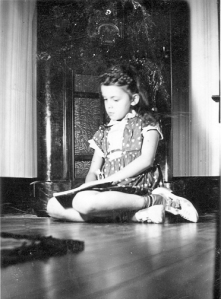
Before the Mickey Mouse Club—before the Flintstones and Batman and Captain Kangaroo, there was the Lone Ranger, Little Orphan Annie, and the Green Hornet. The serial adventures of the 30s and 40s had kids glued to the radio from the time they got home from school until dinnertime. But best of all was a Saturday morning show called Let’s Pretend, a 30-minute dramatization of a different fairy tale each week.
These programs were not a feeble prelude to children’s televised fare of later years. In one respect at least, I think they may have been even better because they demanded that we cultivate the power of our imaginations. That’s me in the picture at the age of 8 or 9; the book on my lap is a prop introduced by my father, the photographer. He probably thought I should look like I was doing something. But listening to these stories was doing something, something intense. We didn’t need the help of illustrations to create imaginary worlds of enchantment in great detail. In my mind’s eye, I can still see the subterranean kingdom I envisioned as a little girl where the trees had leaves of silver and gold and twelve beautiful princesses (with curly hair, I might add) danced all night in a glittering palace with their handsome partners.
 In The Uses of Enchantment: The Meaning and Importance of Fairy Tales, Bruno Bettelheim, the child psychologist, contends that unlike any other form of story, the fairy tale meets the psychic needs of children. Before the child can rationally understand what troubles him or figure out what he must do to be a good independent person, he unconsciously identifies with the symbolic elements of the fairy tale and is comforted and instructed. Separation anxiety, feelings of powerlessness in an adult world, sibling rivalry, fear of growing up—this is the sort of thing the repeated telling of a specific tale can ameliorate.
In The Uses of Enchantment: The Meaning and Importance of Fairy Tales, Bruno Bettelheim, the child psychologist, contends that unlike any other form of story, the fairy tale meets the psychic needs of children. Before the child can rationally understand what troubles him or figure out what he must do to be a good independent person, he unconsciously identifies with the symbolic elements of the fairy tale and is comforted and instructed. Separation anxiety, feelings of powerlessness in an adult world, sibling rivalry, fear of growing up—this is the sort of thing the repeated telling of a specific tale can ameliorate.
Even though one might not accept the Freudian concepts underlying Bettelheim’s analysis, it’s hard to argue with the idea that fairy tales are unique in their ability to meet some of the conscious and unconscious requirements of the listeners. How else to account for their ubiquitous appearance in all cultures and their phenomenal staying power. The oldest record of a variant of Cinderella dates back to the ninth century—in China!
Great post. Listening is the key to happiness. That is what I think anyway. Lots of people and children today do not know how. There is a great stanza in a song from “Into the Woods”— that Stephen Sondheim musical about fairytales. The witch sings, “Careful the tale you tell. That is the spell. Children will listen…”
LikeLike
Several years ago, a first grade teacher who had been teaching for many years, told me that children then had a harder time just sitting and listening to a story than in previous years. They became fidgety and impatient, she thought, because they had been accustomed to having a lot of the work of imagining done for them. (We were probably talking about children’s tv watching.)
LikeLike
Mary, your posts are a treasure and Hints and Echoes deserves a much larger audience!
LikeLike
Thank you, Steven! I hope to post more often this year. I love having you in the audience.
LikeLike
I loved the afternoon serials on the radio, and I guess I listened on the same radio as the one in your picture. It was possible to listen and do something else at the same time. I once created a lovely mural with my crayons on the wallpaper next to the radio during an episode of “The Lone Ranger.” As I recall, it wasn’t appreciated.
LikeLike
That good old RCA radio. Can’t remember when it bit the dust, but I do remember a successor: an ivory Bakelite table model Airline radio, which was my Christmas present when I was ten. The best present I ever received!
LikeLike